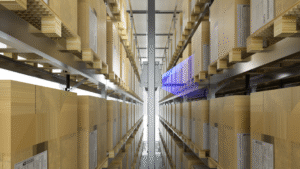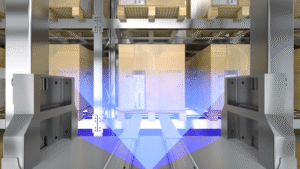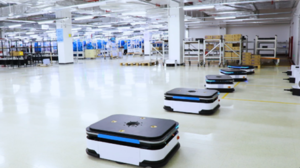How does a robot find its way through a busy warehouse without GPS? In complex indoor environments, smart navigation depends on more than just wheels and sensors—it requires real-time awareness.
That’s where real-time localization comes in. This powerful technology enables robots to continuously track their position, adapt to changing surroundings, and move with precision. In this article, we’ll explore how Real-time localization is transforming indoor robot navigation and unlocking true autonomy in dynamic spaces.
What Is Real-time Localization?
Real-time localization is the process that allows a mobile robot to continuously determine its position while navigating an environment, especially indoors where GPS doesn’t work. It’s the core of safe and intelligent movement.
Here’s what it means and how it works:
-
Continuous Position Tracking The robot updates its exact location in real-time as it moves, ensuring accurate navigation even in dynamic or crowded spaces.
-
GPS-Free Navigation In indoor environments like warehouses or hospitals, robots rely on alternative sensors instead of GPS signals.
-
Sensor-Based Localization Real-time localization uses a combination of sensors such as: – LiDAR or laser scanners – Depth or
RGB cameras – Ultrasonic or infrared sensors – Inertial Measurement Units (IMUs)
-
Often Part of SLAM Many systems combine localization with mapping (Simultaneous Localization and Mapping), allowing robots to explore unknown areas while tracking their own position.
-
Instant Adaptability Because it’s Real-time, the robot can respond immediately to changes—like avoiding people, navigating around new obstacles, or adjusting routes on the fly.
Common Real-time Localization Technologies and Methods
Real-time localization uses various technologies and methods to help robots accurately determine their position indoors. Here are the most common approaches:
-
LiDAR (Light Detection and Ranging)
LiDAR systems emit laser pulses that bounce off surrounding objects to create detailed 2D or 3D maps. This technology is highly accurate and performs well even in low-light or texture-less environments, making it popular in warehouses and industrial robots. However, LiDAR hardware can be costly and may struggle with reflective surfaces that distort measurements.
-
Visual SLAM (Simultaneous Localization and Mapping)
Visual SLAM uses cameras to detect and track visual features within the environment, allowing robots to map surroundings and localize simultaneously. It’s a cost-effective option that provides rich environmental detail and is common in lightweight indoor robots and drones. Its main limitations arise in poor lighting or highly dynamic spaces, where visual cues may be unreliable.
-
Ultrasonic and Infrared Sensors
Ultrasonic and infrared sensors measure distances by timing the reflection of sound waves or infrared light off objects. These sensors are affordable and compact, often found in smaller cleaning robots and simple navigation systems. However, their accuracy and effective range are limited, and they can be affected by soft or uneven surfaces.
-
IMU (Inertial Measurement Unit)
IMUs track a robot’s orientation and movement using accelerometers and gyroscopes. They excel at short-term motion tracking and are commonly integrated with other sensors for dead reckoning when external references are unavailable. The downside is that IMUs suffer from drift over time, reducing accuracy if used in isolation.
-
Sensor Fusion
Sensor fusion combines data from multiple sensors—such as LiDAR, cameras, and IMUs—to provide more reliable and accurate localization. This approach leverages the strengths of each sensor while compensating for their individual weaknesses. Though powerful, sensor fusion demands sophisticated algorithms and increased computational resources.
-
AI-Based Localization
Artificial intelligence enhances localization by improving sensor data interpretation, enabling better feature recognition and predictive navigation. AI-powered systems adapt more effectively to dynamic and cluttered indoor environments, supporting tasks like human-aware navigation. However, these methods require substantial training data, processing power, and careful tuning to perform optimally.
How Real-Time Localization Boosts Navigation Performance
Real-time localization dramatically improves a robot’s ability to navigate complex indoor environments by providing accurate, up-to-the-moment positioning. This continuous awareness translates into several key navigation benefits:
-
Accurate Position Tracking: By constantly updating its exact location within a map, the robot can avoid drift and errors common with less frequent localization methods. This accuracy ensures it stays on the intended path, reducing detours or collisions.
-
Dynamic Obstacle Avoidance: Indoor environments are often busy and unpredictable. Real-time localization allows robots to detect moving obstacles like people, carts, or furniture and quickly adjust their routes to prevent collisions, ensuring safe operation.
-
Efficient Path Planning and Re-Routing: With up-to-date location data, robots can recalculate optimal routes on the fly. If an obstacle blocks the original path or the environment changes, the robot can dynamically find a new, efficient path without stopping or human intervention.
-
Improved Task Completion Speed: Reliable localization reduces errors and unnecessary stops, enabling robots to perform tasks like delivery, picking, or cleaning faster. This efficiency directly boosts overall productivity in warehouses, hospitals, and other indoor settings.
-
Enhanced Reliability in GPS-Denied Areas: Since GPS signals don’t penetrate buildings well, Real-time localization provides an essential alternative, enabling smooth navigation where traditional positioning systems fail.
Applications of Real-Time Localization in Indoor Robots
Real-time localization is transforming how robots operate across a variety of indoor settings. Below are key applications where this technology plays a crucial role:
Warehouse Automation
In warehouses, Real-time localization enables robots to navigate complex aisles and shelves efficiently. Robots use accurate positioning to pick, transport, and sort inventory with minimal errors, even in busy environments where forklifts and human workers move around constantly.
Healthcare and Hospitals
Service robots in hospitals rely on real-time localization to safely deliver medications, equipment, and meals. These robots must navigate crowded corridors and dynamic environments filled with patients and staff, adapting instantly to obstacles to maintain smooth and timely operations.
Office and Facility Management
Indoor delivery robots in office buildings use real-time localization to transport documents, supplies, and refreshments. By accurately tracking their location, these robots avoid crowded areas and optimize routes to complete tasks quickly without disrupting daily workflows.
Retail and Hospitality
Robots in retail stores and hotels leverage Real-time localization to guide customers, deliver items, or assist with cleaning. Navigating busy, ever-changing spaces requires constant position updates to interact safely with customers and staff while providing efficient services.
Autonomous Cleaning Robots
Robotic vacuums and floor scrubbers use real-time localization to map rooms and track progress. This ensures thorough cleaning without repetition or missing spots, and helps them avoid furniture and moving people during the operation.
Why Choose MRDVS for Real-time Localization?
When selecting technology to power Real-time localization in indoor robots, it’s essential to partner with a provider that offers precision, flexibility, and cutting-edge innovation. Here’s why
MRDVS stands out as a top choice for advancing your robot’s navigation capabilities:
-
Industry-leading Depth Camera Technology: MRDVS provides sensors with excellent depth accuracy and frame rates, enabling smooth, real-time environment scanning.
-
Comprehensive Support for SLAM and AI Integration: Their products are compatible with popular SLAM frameworks and can be enhanced with AI for semantic understanding and predictive navigation.
-
Customizable and Scalable Solutions: Whether for compact service robots or larger automated guided vehicles, MRDVS offers tailored options to meet diverse localization needs.
Investing in MRDVS technology means equipping indoor robots with the best tools to navigate complex, dynamic environments confidently and efficiently.
Conclsuion
Boosting indoor robot navigation with real-time localization is key to unlocking smarter, more efficient automation in complex environments. By integrating advanced depth sensing and precise positioning technologies, robots can navigate safely and adapt dynamically to changing surroundings. MRDVS offers cutting-edge solutions that empower your robots with reliable real-time localization, ensuring seamless operation and enhanced productivity. Discover how MRDVS can elevate your indoor robotics—get in touch today to transform your navigation capabilities!



